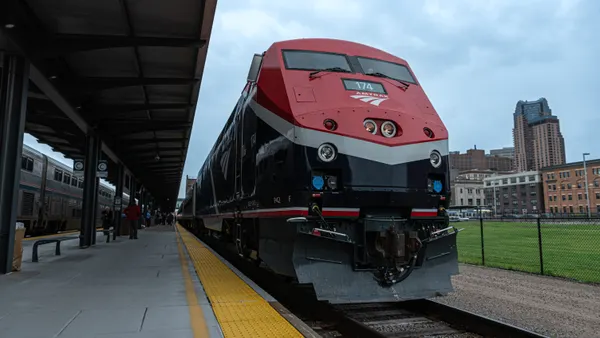Dive Brief:
- Seattle leaders are investigating the possibility of introducing congestion pricing to reduce traffic congestion and vehicle emissions.
- The city's Department of Transportation (DOT) completed a study examining existing data — which it admits is limited at this point — on the impacts and benefits of congestion pricing in other cities and how it could be applied locally. The DOT identified 11 pricing options used in other cities that could apply to Seattle, and narrowed that down to four options to target for additional examination.
- Equity is at the forefront of the city's congestion pricing discussion. The study highlights how low-income residents and people of color could be disproportionately burdened by an extra charge without proper protections in place.
Dive Insight:
Seattle's population has grown by 17% since 2010 and more expansion is expected throughout the region. The 105,000 extra people equate to additional cars on the road, resulting in the city ranking among the top five most congested in the country. Congestion pricing aims to reduce the traffic in the city center, specifically passengers driving alone in a vehicle. Lessening traffic would also decrease vehicle emissions.
The study dug into what other cities have done with congestion pricing but it didn't lay out a policy or guidelines for exactly where in Seattle congestion pricing should occur or how much the charge should be. In fact, it didn't outright say the city would move forward with such a structure, just that it could benefit from the environmental and traffic lessening aspects of a properly carried out plan. The analysis primarily focused on congestion pricing in Europe because the U.S. lacked programs until New York City approved one this spring.
The study emphasizes the need to identify citizens who would face a disproportionately high burden from the system and to develop a racially and socially equitable congestion pricing plan. It states the average Seattle household spends 15% of its budget on transportation, but that number can get up to 30% for low-income households. And the areas of Seattle with the worst air quality are those that are predominantly communities of color.
Plus, lower-income residents are being forced away from the city center as the cost of living rises, increasing their transportation costs. Adding congestion pricing on top of the commute expense could prove excessively troublesome for this population, especially hourly workers who often don't have the same flexibility as salaried employees.
In addition to narrowing down the most applicable pricing schemes to four, the study considered that new technologies might be necessary to launch a new program. For example, the pricing zone border might need to be outfitted with overhead vehicle identifiers and individual vehicles would need onboard detectors to assess fees.
The need for citizen outreach and developing communication about a new system also was prominent. For residents to correctly participate in the system, the city must be provided advance, clear information about how it works. The study says citizens tend to resist congestion pricing at first but accept it over time, especially with high levels of communication about what it intends to achieve.
Seattle's congestion pricing conversation is in the very earliest stages and "[m]uch work remains before we will be ready to implement congestion pricing," the study concludes. In addition to more research, planning and engagement, a majority of Seattle voters would have to approve the plan and the state Transportation Commission might have a role in setting rates.












